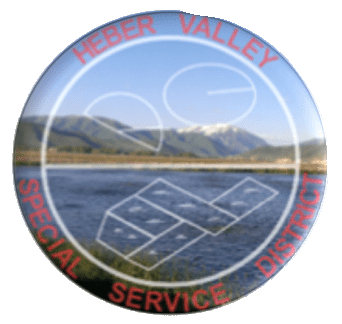To serve you better, we've assembled a list of our customers' most frequently asked questions. If you don't find your answer here, feel free to contact us.
Is HVSSD condemning 200 acres for more sewer ponds and the discharge of hazardous water?
The 200 acres that received an HVSSD proposed eminent domain notice would remain as farmland.
Effluent water is already used on the 375 acres currently farmed by HVSSD. This water is treated, tested, and safe for farming techniques used by HVSSD which meets State and EPA standards. The proposed land is adjacent to the existing facility and is needed to increase disposal capacity.
The proposed farmland considered under eminent domain will increase HVSSD's disposal capacity by growing more crops with treated effluent water.
Will there be an expansion of sewer lagoons in Midway?
No, HVSSD is not proposing to expand any existing lagoons. The HVSSD sewer plant is actually in Wasatch County, but it does border Midway.
The EPA approved the current location in 1978 when it was built. Since then Midway grew much closer.
Are sewer ponds (lagoons) outdated?
No, even though wastewater lagoons have been used for thousands of years, they are operationally the most economical and lowest carbon footprint technology for wastewater treatment.
If sewer ponds are so great why aren't they in every city?
High population cities usually don't have available land to build lagoons needed for their density.
63% of municipal wastewater systems in Utah use lagoons/wastewater ponds.
Every community along the Wasatch Front has gone to a mechanical plant. Most recently Timpanogas. Why not us?
The Timpanogas Special Service District (TCSSD) in Utah County has used a mechanical plant since it started back in 1977.
Why not move the sewer plant to Heber?
Let's consider all of the costs for moving the current plant:
- Cost of engineering, EPA and other environmental studies
- Cost of design work of a new mechanical plant
- Cost of getting the State of Utah and EPA approvals and permits
- Cost of buying new land for the plant and winter storage ponds
- Cost of building a new mechanical plant with the same capacity
- Cost of additional staff and O&M to run a larger plant
- Cost of new collection system piping
- Cost of pumping sewage from Midway
- Cost of impact fees and sewer rates
Even with a new plant, HVSSD will still need to dispose of its treated wastewater effluent. HVSSD still needs to increase it's disposal capacity by acquiring more farmland; whether by keeping the existing plant or building a new plant.
An official study would need to be completed, at additional expense.
It costs less money to HVSSD ratepayers to use all of the current plant's treatment capacity and acquire additional farmland for disposal capacity.
A published study by BYU in 2014 claims that there is seepage from Midway sewer lagoons into the Provo River.
This study was a master thesis done by a BYU studing in 2014. This thesis was not reviewed or accepted by the State of Utah Division of Water Quality or EPA.
HVSSD lagoons were designed to be and are in compliance with state and federal regulations.
Is the sewer district planning to spend $38 million to condemn land through eminent domain?
No, the $38 million was a preliminary estimate from a draft report discussed in an HVSSD meeting.
That draft report included other costs for projected operations and maintenance, projected farm maintenance needs, different lab proposals, as welll as projected land costs for disposal capacity needs.
The $38 million figure was not approved by HVSSD at that board meeting, and still has not been approved.
Is a mechanical plant the logical way forward for HVSSD. What has the district done about looking into this?
HVSSD did build a mechanical plant in 2012 to expand it's treatment capacity. At the time HVSSD did not expand it's disposal capacity. Now it needs to.
With growth in the valley, HVSSD needs to increase it's disposal capacity by buying more farmland and building more winter storage.
This increased farmland for effluent disposal should match the existing HVSSD treatment capacity from the existing mechanical plant and wastewater lagoons.
If HVSSD ever goes to a mechanical plant will odors stop?
No. As long as humans emit odors in the bathroom then both mechanical plants and lagoons will emit odors.
Whether HVSSD uses lagoons or a mechanical plant there are odors in wastewater treatment.
HVSSD is committed to keeping any odors to a minimum. In spring of 2020 we experienced a very rare upset due to some much needed repairs. With these repairs completed the odors have been minimized, and further corrective actions are in place.
Can JSSD (Jordanelle Special Service District) take some of the sewage coming to the current plant?
No. Up until August 2020 JSSD was sending their sewage to HVSSD for treatment.
The JSSD mechanical plant is designed for a 1 MGD (million gallons per day) capacity; whereas HVSSD is designed for four times that.
Consider the costs of pumping that much HVSSD sewage to JSSD, as well as the additional costs for JSSD to expand and treat it.
JSSD connection fees, sewer rates and impact fees would dramatically increase higher than current HVSSD rates because JSSD would need to take on all of the costs.
Why can't the ponds be made to look like natural ponds rather than rectangular man-made ponds?
Lagoons must be a certain size/design standard as per state regulations. HVSSD met those requirements when they were originally built.
Any new lagoons could be shaped somewhat differently, but HVSSD is not proposing to build any new lagoons.
At this point HVSSD needs more farmland to increase disposal capacity and match the existing treatment capacity.

